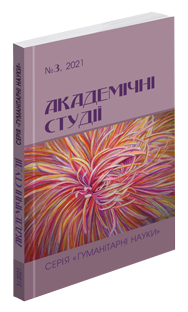Abstract
The paper deals with the description of COVID-19 as a taboo topic in the interdictive communication of the English- speaking society in the ecolinguistic aspect and aims at revealing the semantic, phonetic and word-formation characteristics of euphemistic lexicalization of COVID-19 as well as establishing the role of euphemisms in speech and language rehabilitation. Interdictive communication is defined as been restrained by artificial restrictions and prohibitions – taboos that, according to speech etiquette, should be veiled by euphemisms. The research is performed in the mainstream of linguistic ecology which postulates the interdependence of language, speech and the ecosystem in which they exist – a communicative space where interaction aimed at harmonious socialization is realized. The linguistic ecosystem is characterized by a specific reciprocity of elements predetermined by a set of parameters within different models and depends on the number of linguotoxic elements that pose a threat to the language environment, among which is taboo. Euphemistic lexicalization within the framework of ecolinguistic theory is recognized as a means of therapeutic function of language and rehabilitates taboos in interdictive communication. Euphemistic (“veiling”) units are formed due to a number of formal techniques (semantic, phonetic and word-forming). The formal techniques used to create euphemisms in the fragments of the present-day English-language discourse include synonymization (the use of semantic and stylistic synonyms), metaphorization, the use of acronyms, “language game” and blending. The euphemisms for COVID-19 and related subjects / phenomena / events in the discursive fragments studied are aimed at the alleviating of fear experienced by the recipients of the messages.
References
Бацевич Ф. С. Основи комунікативної лінгвістики: підручник. Київ : Академія, 2004. 344 с.
Колтунова М. В. Конвенции как прагматический фактор делового диалогического общения. Москва : Акад. гуманитар. исслед., 2005. 228 с.
Никитина Н. Н. Формальные способы образования эвфемизмов в английском языке. Известия ВГПУ. Вопросы германистики. 2009. № 4. С. 123–127.
Соковин В. М. О природе человеческого общения (опыт философского анализа). Фрунзе : Мектеп, 1973. 116 с.
Эмотивная лингвоэкология в современном коммуникативном пространстве : коллективная монография. Волгоград : Изд-во ВГСПУ «Перемена», 2013. 450 с.
Aldersey-Williams H. On the Irresistible Pull of Tidal Metaphors. The Language of Love and Death Deep Beneath the Sea. Literary Hub. 2016. September 20. URL: https://lithub.com (дата звернення 12.10.2021).
Dominguez P. Linguistic interdiction: its questions and possible future research lines. Language Sciences. 2009. Vol. 9, Issue 4. P. 428–446.
Linfoot-Ham K. The Linguistics of Euphemisms. A Diachronic Study of Euphemisms. 2005. P. 230–232.
Olaimat A., Aolymat I, Nour E., Shanbaz H, Holley R. Attitudes, Anxiety, and Behavioral Practices Regarding COVID-19 among University Students in Jordan : A Cross-Sectional Study. The American journal of tropical medicine and hygiene. 2020. P. 1–7.

